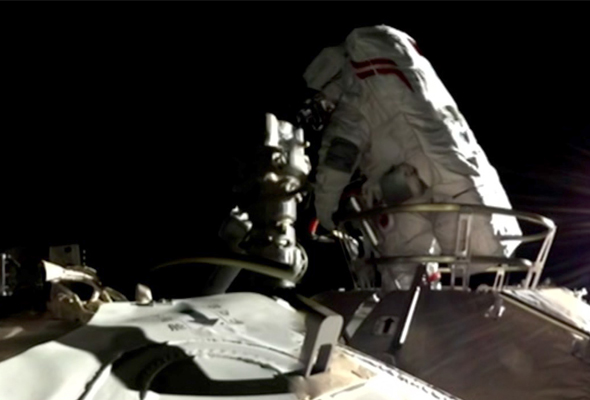Shenzhou-12 astronauts conduct first-ever extravehicular activities
2021-07-04 15:43

Liu Boming and Tang Hongbo, two of the three Chinese astronauts, ortaikonauts, stationed in the Tianhe core module of China's space station Tiangong on Sunday ventured outside to conduct the first extravehicular activities of their current mission, with the support of a robotic arm.
This is the second spacewalk that Chinese astronauts have carried out since the Shenzhou-7 mission in 2008, during which Liu helped his teammate Zhai Zhigang perform a landmark 20-minute spacewalk.
Clear division of work
Liu, who went out of the core module at around 8:26 a.m. Beijing time, has installed foot restraint and workbench on the robotic arm and then will be transferred by the robotic arm to install relevant equipment.
Tang started his spacewalk at around 11:02 a.m. Beijing time. Aided by the handrails mounted on the space station, he will crawl to the operation site cooperating with Liu. At the same time, Nie Haisheng, commander of the mission, remains inside the core module to support the pair's operation outside.
They will also carry out an emergency return test.
"In case of any emergency during the extravehicular activities, astronauts must return to the airlock cabin quickly, and then use the emergency oxygen supply in the cabin to ensure their safety," Wang Yanlei, director of China Astronaut Research and Training Center in Beijing, told China Media Group. "So we need to do the verification."
Task-oriented operation
One of the astronauts' tasks is to install a lifting bracket for one of the extravehicular panoramic cameras, which was initially installed at a lower position on the robotic arm, with a limited vision.
At 12:09 Beijing time, Liu and Tang successfully lifted the panoramic camera.
A wider perspective of the camera is required for the astronauts to monitor the situation outside the space station, so the astronauts need to install a bracket to lift the camera higher, said Wang.
Operating the robotic arm is nothing easy, which is conducted by Nie.
The ground personnel can control the robotic arm for a wide range of transfers, but the astronaut in the space station can perform the task more accurately.
"Due to limited monitoring approaches from the Earth, it is necessary for the astronaut inside the space station to communicate through voice with the spacewalking astronauts, and make instructions to them," said Wang.
All astronauts, both inside and outside of the space station have access to the emergency stop device, he said.
"The astronauts for extravehicular activities can directly press the device once they face a risk of collision, and the robotic arm will stop working," he added.
